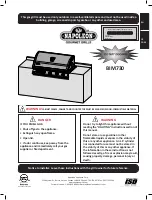
USING CHARCOAL AND WOOD
CHARCOAL
Your charcoal grill is made to burn either charcoal brique
tt
es or natural wood lump charcoal – both
of which have di
ff
erent cooking a
tt
ributes. Brique
tt
es typically provide longer burn
tim
es than lump
charcoal – but lump charcoal burns ho
tt
er than brique
tt
es. Using the charcoal pan access door to
add more charcoal makes both brique
tt
es and lump easy and convenient for extended cooking
tim
es.
SMOKING WOODS
Adding smoking woods to your charcoal grill is an easy and e
ff
ec
ti
ve way to create wonderful
fl
avor
combina
tions
for all types of grilled, barbecued, or slow smoked foods. Wood chips are typically
used for shorter cooking
tim
es, where chunks are be
tt
er for longer cooking
tim
es.
When choosing smoking woods, the rule of thumb is to use a fruited hardwood – from a tree that
bears a nut, fruit, or berry. The most popular and widely available smoking woods are hickory and
mesquite. Hickory imparts a milder
fl
avor, where mesquite is more intense. Other common wood
varie
ti
es are oak, apple, pecan, cherry, etc.
It is important to never use pine, cedar, or kiln dried wood – and any smoking woods should be well
cured. Green wood s
ti
ll contains all the sap and moisture needed to keep the tree alive, and will
impart a super strong-tas
ting
smoke that will turn your foods black. Also, when you try burning
green wood, it is hard to reach a good temperature, because all the moisture inside the wood
almost puts the
fi
re out while it’s burning. Well-cured wood lights easily, maintains cooking
temperature, and produces a great tas
ting
smoke
fl
avor that isn’t too strong.
The amount of smoke
fl
avor imparted to your food can be controlled by not just the type of wood
you use (whether a mild wood or more intense), but also by the length of
time
the meat is smoked.
Barbecuing typically adds more smoke
fl
avor to food than grilling, due to the longer cooking
tim
es.
You can also control the amount of smoke
fl
avor by wrapping meats in aluminum foil for part of the
cooking process. Cook meat for ½ to 2/3 of the total cooking
ti
me, or un
ti
l it looks to be the perfect
color. Then wrap the meat in foil and
finish
cooking the meat un
ti
l done.
8










































